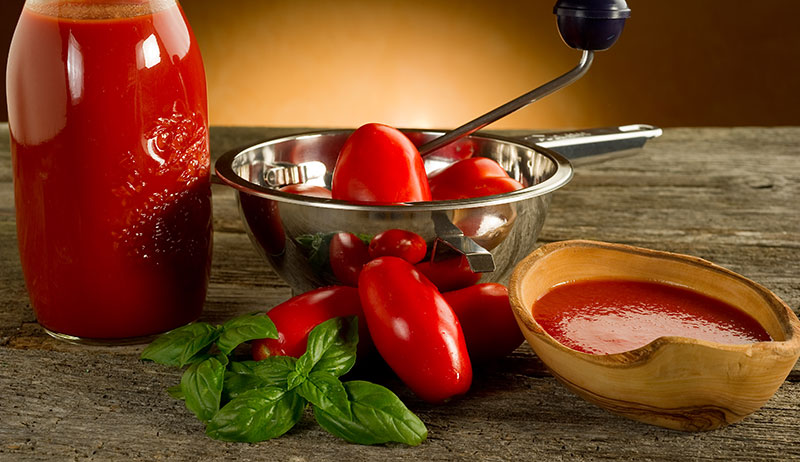
This fall, as my husband and I picked persimmons from the trees on our land, we found ourselves in need of a kitchen gadget I’d never had a use for in the past: a food mill. While I’m all for adding to my culinary arsenal, I’m leery of tools with singular uses—particularly those that seem to be easily replaced by modernized equipment. However, as simple and old-fashioned as the food mill seemed to be when I first got my hands on it, I quickly learned that it’s a tool that my kitchen can no longer do without.
Many people’s first thought when considering the food mill is, “Can’t I just use my food processor?” While food processors and blenders can do much of the work that a food mill can, the resulting product doesn’t quite match up. A food mill consists of a hand crank attached to a bowl, typically with three or four perforated disks of various textures that attach to the bottom of the bowl. As you turn the crank, a grinding plate mashes the food against the perforated disk, causing the desired pulp to go through while sieving out the undesirable skin and seeds.
While you can do similar work with a food processor or blender paired with a sieve, a food mill does the job more quickly and efficiently. For us, it was the only option for processing persimmons, which have a gooey pulp that doesn’t easily release itself from the fruit’s large seeds and fine skin. Although it will take up some kitchen-cabinet space, the low price point (about $25 to $35 for standard versions) and versatility of this forgotten-about kitchen tool make the trade-off worth it.
If you’re considering a food mill, here are some uses to make it worth your while.
1. Creamy Soups
Creamy soups, such as butternut squash and apple soup and rustic potato stews, are mainstays in our household, and here is where a food mill excels. Run the boiled, steamed or roasted ingredients through the food mill for a texture that is lighter and more airy than what you would achieve with an immersion blender.
2. Pureed Fruit for Treats
Are you a fan of cake with a raspberry filling or ice cream with a strawberry swirl? With a food mill, you can hand-make the filling for your favorite treats without the fuss. It allows you to process berries and grapes while keeping undesirable seeds and skin out of the final product. While you can always strain your fruit purees using a sieve and wooden spoon, a food mill wastes less fruit and gets the job done at record speed.
3. Bean Dip
I love hummus, but I’m not a fan of the gritty texture of my homemade recipe caused by processing the chickpeas with skins on. While I’ve read about ways to remove the skins, to me, it’s not worth the effort for a snack that will be gobbled down in minutes. However, with a food mill, you can easily process the beans into a smooth and consistent paste that will up your hummus game. And don’t think chickpeas are the only bean you can run through your food mill—try black beans, pinto beans, cannellini beans or your go-to bean-dip bean.
4. Tomato Sauce
Many notable chefs and homecooks wouldn’t be caught making tomato sauce without the help of their food mill. After cooking the tomatoes, simply run them through the food mill and then mix with your favorite ingredients. You’ll be left with a sauce that is smooth, red, and free of skin and seeds.
5. Baby Food
If you plan to make baby food for your infant, a food mill is essential. Cook your fruits and vegetables however you desire, and then run them through the food mill for a fast puree that can be frozen or canned for easy access. Store as single foods, or cook up a gourmet meal for your child with multi-food purees.
6. Ground Meat
While a meat grinder is typically used to transform raw meats into ground meat, a food mill can be used to process your cooked leftovers. Turn that Thanksgiving turkey or Christmas ham into ground meat for salads and spreads using your food mill (and a little bit of muscle).
7. Applesauce
If you use your food mill for nothing else, use it for applesauce. In my pre-food-mill days, I would peel and core my apples before processing them down to sauce. With a food mill, you can save yourself the time, effort and achy hands of peeling and coring by running them through the food mill whole after cooking.
8. Mashed Potatoes
According to enthusiasts, a food mill yields fluffier mashed potatoes than a masher, potato ricer or even electric mixer. Fix your food mill with the smallest-holed disk, and mill away. To add extra flair to your potatoes, you can even add in some whole cooked garlic to the food mill before processing.
9. Spaetzle
If you want to make a homemade noodle dish that will impress without all the work that goes into kneading and flattening typical semolina noodles, turn to spaetzle. These German poached egg noodles require only a few ingredients, and you can serve them with the traditional pork-and-mushroom sauce or topping of your choice. Easily make your own by combining flour, eggs, milk, butter and spices, and then run the dough through your food mill fitted with the largest-holed disk.
Your kitchen doesn’t have to be stocked with fancy, high-tech gear for you to enjoy farm-fresh meals at home. Turn to simple, time-tested kitchen gadgets like the food mill, and your only limitation will be your imagination.





